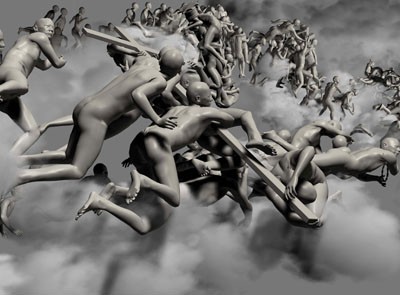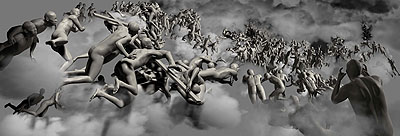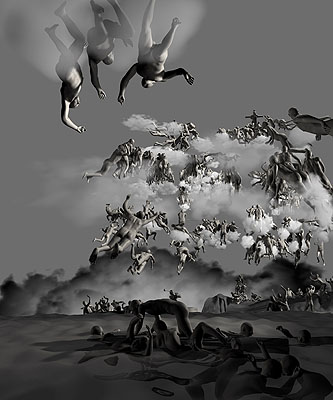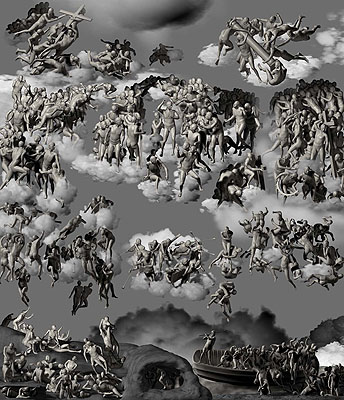
MIAO Xiaochun »
The Last Judgment in CyBerspace
Exhibition: 12 May – 17 Jun 2006
ALEXANDER OCHS GALLERIES BERLIN I BEIJING
Sophienstr. 21
10178 Berlin

ALEXANDER OCHS PRIVATE
Schillerstr. 15
10625 Berlin
+49 (0)30-45 086 878
ochs@alexanderochs-private.com
www.alexanderochs-private.com
Wed-Fri 13-18, Sat 11-15
The Chinese artist Miao Xiaochun (*1964) has achieved prominence in recent years with his photography: his photographs have been shown at numerous biennials and are included in the collections of several museums in Europe and China. In his current work, he has turned to 3D technique to develop his very own interpretative rendition of Michelangelo's The Last Judgment. The fresco in Rome's Sistine Chapel was painted from 1536 to 1541, and is one of the key works of Western art history. The blue background is populated by constellations of figures that were unusual at the time: an Apollonian Jesus surrounded by athletic angels and apostles. The religious message does not stand at the foreground; instead, Michelangelo proves himself a master in the art of depicting the movement of individual bodies. In The Last Judgment in CyBerspace Miao Xiaochun engages with the fascination with this work. He explores the question: What does a painted figure see? What do the protagonists in the fresco see? Miao Xiaochun provides us with a glimpse behind the curtain, so to speak. He masterfully makes use of digital technology to make the painting transparent, opening five different perspectives onto Michelangelo's work. Miao Xioachun creates a computer-made sculpture of his own body, thus replacing Michelangelo's entire constellation of figures. He places these doubles in virtual space, in so doing strictly following the visual construction of the classical model. This technique allows the artist to wander through the construction, like a tourist. "I can now move in this space, choose my own point of view and make my own image." It thus becomes possible to see the image from various perspectives, be it from the outside or inside. Five of these new points of view are shown on large-format prints (for example 244 cm by 720 cm) in the exhibition 'The Last Judgment in CyBerspace': two interior views, three from the outside. In a video, all possible perspectives are mixed, dissolved, and reformulated. Miao Xiaochun studied art at Nanjing University and the Central Academy of Fine Arts (CAFA) in Beijing, and was a DAAD fellow at Kunsthochschule Kassel (1995-99). In 1999, he was named professor at CAFA, where he today leads the Medialab. Miao Xiaochun's work has been shown at numerous exhibitions: Shanghai Art Biennale (2002); 2nd Seoul Media Biennale (2002); Me and More, Kunstmuseum Luzern (2003); Pinyao in Paris, Bibliothèque nationale de France - François Mitterrand (2003); Between Past and Future: New Photography and Video from China, International Center of Photography and Asia Society (New York) Smart Museum of Art and Museum of Contemporary Art (Chicago) Victoria and Albert Museum (London), Haus der Kulturen der Welt (Berlin) (2004-2006); Guangzhou International Photo Biennale' Guangdong Art Museum (2005); Chengdu Biennale (2005); Confluentes II: International Artists in Ludwig Museum Koblenz (2005); New Urban Reality, Museum Boijmans Van Beuningen (Rotterdam, 2006); Totalstadt: Beijing Case ZKM (Karlsruhe, 2006). Catalogue: Wu Hung (ed.), The Last Judgment in CyBerspace. __________ deutsch __________ Wurde der chinesische Künstler Miao Xiaochun (*1964) in den letzten Jahren durch seine photographischen Arbeiten bekannt und bei zahlreichen Biennalen als auch in europäischen und chinesischen Museen gezeigt, nutzt er nun die 3d-Technik um eine sehr eigene Rezeption des Freskos 'Das Jüngste Gericht' Michelangelos zu entwickeln. Das Fresko, zu finden in der Sixtinischen Kapelle in Rom, entstand zwischen 1536 und 1541 und ist ein Hauptwerk der westlichen Kunstgeschichte. Auf blauem Grund gruppieren sich Figuren-konstellationen, die für die damalige Zeit ungewöhnlich waren: ein apollinischer Jesus umgeben von athletischen Engeln und Aposteln. Nicht die religiöse Botschaft steht im Vordergrund, vielmehr beweist uns Michelangelo, ein Meister darin zu sein, die Bewegung der einzelnen Körper in Perfektion darzustellen. Mit der hiervon ausgehenden Faszination setzt sich Miao Xiaochun in 'The last Judgement in CyBerspace' auseinander. Er beschäftigt sich mit der Frage: "Was sieht eine gemalte Figur?" Was sehen die Protagonisten des Freskos in dem Augenblick des allerhöchsten Gerichts? Miao Xiaochun gewährt uns sozusagen einen Blick hinter die Kulissen: meisterhaft lässt er das Gemälde mit Hilfe digitaler Technik transparent werden und offenbart dem Betrachter fünf verschiedene Perspektiven auf Michelangelos Werk. Miao Xioachun kreiert eine am Computer geformte Skulptur seines eigenen Körpers und 'ersetzt' damit Michelangelos gesamte Figurenkonstellation. Er platziert diese Doubles im virtuellen Raum und folgt dabei stringent dem Bildaufbau der klassischen Vorlage. Die eingesetzte Technik ermöglicht es dem chinesischen Künstler gleichsam wie ein Tourist durch die neue Konstruktion zu wandern: "Ich kann mich jetzt in diesem Raum bewegen, meinen Blickwinkel wählen und Bilder machen." So wird es möglich, das Bild aus verschiedenen Perspektiven zu betrachten, sei es von außen oder von innen. Fünf dieser neuen Ansichten werden auf großformatigen Prints (beispielsweise auf 244 cm x 720 cm) in der Ausstellung 'The last Judgement' präsentiert: zwei Darstellungen von innen, drei von außen. In einem Video mischen sich alle Perspektiven, lösen sich auf und formulieren sich neu. Miao Xiaochun studierte an der Nanjing University und der Central Academy of Fine Arts (CAFA) in Beijing sowie als DAAD Stipendiat an Kunsthochschule Kassel (1995-1999). 1999 wurde er von der CAFA als Professor berufen und leitet dort das Medialab. Miao Xiaochun wurde und wird international ausgestellt: Shanghai Art Biennale (2002); 2nd Seoul Media Biennale (2002); 'me and more' Kunstmuseum Luzern (2003); 'Pinyao in Paris' Bibliothèque nationale de France - François Mitterrand (2003); 'Between Past and Future - New Photography and Video from China' International Center of Photography and Asia Society New York, Smart Museum of Art and Museum of Contemporary Art Chicago, Victoria and Albert Museum London, Haus der Kulturen der Welt Berlin (2004 - 2006); 'Guangzhou International Photo Biennale' Guangdong Art Museum (2005); Chengdu Biennale (2005); 'Confluentes II' International Artists in Ludwig Museum Koblenz (2005); 'New Urban Reality' Museum Boijmans Van Beuningen Rotterdam (2006); 'Totalstadt. Beijing case' ZKM Karlsruhe (2006). Katalog: Wu Hung (Hrsg.): The Last Judgement in CyBerspace.


